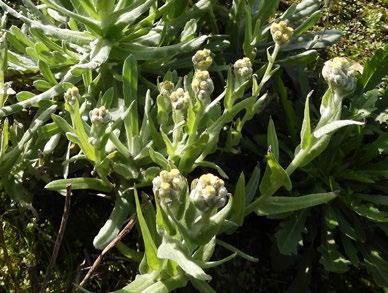
6 minute read
Rosemary Parslow & Ian Bennallick
Three aliens from the Isles of Scilly
ROSEMARY PARSLOW & IAN BENNALLICK
Advertisement
The Isles of Scilly are the sort of place where anything might turn up. This small archipelago of c.200 rocks and islands (five of which are inhabited) is some 40km off the mainland of Cornwall. Blessed with a mild and usually frostfree climate and surrounded by the Atlantic Ocean, the low-lying islands are subject to fierce salt-laden winds. But despite that, many plants from more temperate climates can thrive there. This leads to an unusual flora with native plants growing alongside species from warmer climes.
The Abbey Gardens on Tresco have usually been identified (or blamed) as the source of many established aliens, but this is not always so. When flower farming was the main source of the economy many kinds of plants were trialled as possible alternatives to the winter-flowering Narcissus. Some of these plants, although rejected as no use commercially, accidentally became established as ‘weeds’ – for example Gladiolus communis subsp. byzantinus. Some weeds arrived as contaminants in seed mixes or with goods. Scilly islanders are keen gardeners and often introduce tender plants to their gardens. Other plants just appear and we have no idea how they arrived or where from.
Although RP had spent winter 2019–20 living on St Mary’s she had returned to the mainland and was in lockdown when news of three unusual plant finds were brought to her attention. They had been reported by birdwatchers visiting Scilly in October 2020.
The first plant was found by Jon Holt, and after his photos were posted on Facebook several different identifications were suggested. RP recognised it as possibly the same plant found growing on Tresco since 2007 and identified as Pearly Everlasting Anaphalis margaritacea, a garden escape. That identification now seemed doubtful and some kind of cudweed seemed more likely. Comparison with photos on the internet found that Gnaphalium stramineum Kunth, now known as Pseudognaphalium stramineum (Kunth) Anderb., was the most likely candidate. Voucher specimens and photographs were sent to Eric Clement who was eventually able to confirm the identification, although he pointed out that although the plant was most likely this,
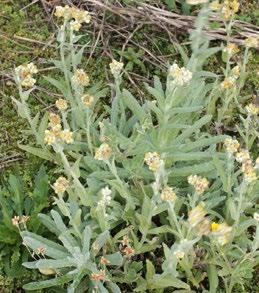
Pseudognaphalium stramineum growing in a rough field on St Mary’s, Isles of Scilly. Left: Jon Holt. Right: with Laphangium luteoalbum at bottom left of image. Liz Askins
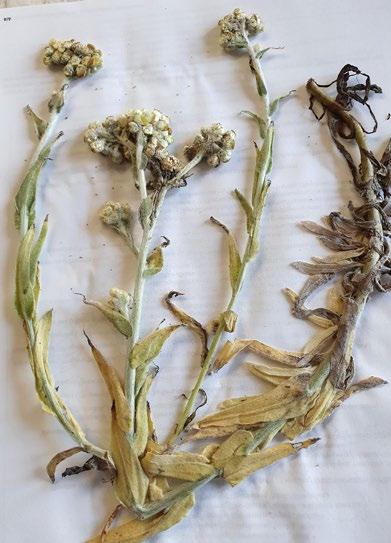
Pressed specimen of Pseudognaphalium stramineum from St Mary’s. Rosemary Parslow
the nomenclature of the group is fairly confused. The plant is native to California and is found in many habitats including roadsides. The habitats on Tresco are gravelly path edges and a rubbish dump. More Pseudognaphalium stramineum plants were later discovered on another island, St Mary’s, growing beside Laphangium luteoalbum (Jersey Cudweed).
Then a large Cyperus was found in a damp field near Lower Moors (SV 90959 10490) by John Martin while looking for a Radde’s Warbler! He contacted a number of aquatic plant specialists including Gerhard Wiegleb who identified the plant as Cyperus ustulatus A. Rich., native of New Zealand, and abundant in the North Island and northern South Island. A photo was circulated to the members of the IUCN SSC Freshwater Plant Specialist Group and several specialists also identified the plant as Cyperus ustulatus. It does not appear to be grown as a garden plant although it is quite striking. There is a slight concern it could invade the adjoining Lower Moors SSSI. Liz Askins visited the site later to take photos and found there were two plants.
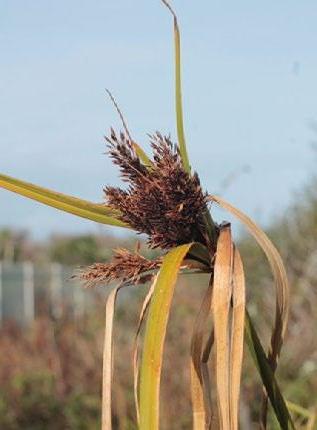
Cyperus ustulatus found in a wet field near Lower Moors, St Mary’s, Isles of Scilly. Liz Askins
The third plant is very puzzling as it was found in some quantity in two fields on a bulb farm but does not appear to have seen previously. Initial research led to the plants being identified as Calandrinia ciliata (Ruiz & Pav.) DC. but after correspondence with Mark Hershkovitz, an expert in Montiaceae, the plants in Scilly have been identified as Calandrinia menziesii (Hook.) Torr. & A. Gray. This species is native to western North America (California to New Mexico and Baja California). Marks says that ‘Calandrinia menziesii was classified into many species in the mid-20th century, eventually treated as the same as Calandrinia ciliata (e.g., the FNA website) or merely a variety. My DNA paper in 2006 showed that lowland weedy plants from the US Pacific states, mainly California, are genetically
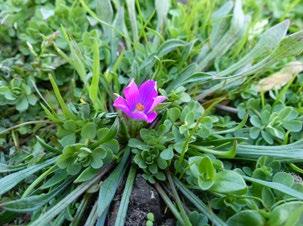
Calandrinia menziesii growing in fallow field on St Mary’s, Isles of Scilly. Left: Tim Harrison; middle, right: Liz Askins
quite diverged from the tropical mountain C. ciliata, and, just as importantly, menziesii is more closely related to C. breweri than it is to C. ciliata. This is why I recognized menziesii as a distinct species from ciliata.’ Calandrinia menziesii is included under C. ciliata in Clement & Foster (1994). Interestingly, Calandrinia umbellata (Ruíz Lopez & Pavón) DC. is also listed in Clement & Foster (1994) for Scilly. This was apparently recorded from a field on St Mary’s in around 1983 by Clare Harvey, the previous botanical recorder on the Isles of Scilly. However, with no other details or recent records of the occurrence of C. umbellata, this led us to wonder if the C. umbellata record was an error, and in fact the plants were C. menziesii. The plants seen in 2020 seem an unlikely garden escape: Liz Askins who collected voucher specimens described it as being ‘weedy and tangled, only when the flowers open in sunshine does it become noticeable’. C. ciliata has been recorded as a grain and seed alien from sandy ground in Norfolk (in 2019), Devon (in 1955) and on Sark (Channel Islands) in 1957. It would be interesting to see if the plants recorded as C. ciliata are actually C. menziesii. Mark Hershkovitz notes that ‘C. menziesii plants are generally larger and with more stamens than C. ciliata, but small and less well-developed plants of C. menziesii cannot be distinguished visually from C. ciliata. Besides genetics, however, the species are also distinct ecologically. C. menziesii is rather aggressive and naturalized in lowland sites in the Falkland Islands, New Zealand, Australia and South Africa. I would agree that the introduction in Scilly most likely is recent, as seeds of the species are sold commercially, sometimes alone, sometimes in wild flower mixes*. The question is whether it is truly naturalized on Scilly. There are collections of this species from several localities in Europe, including Czechia and Finland. All of these records seem to be associated with ornamental gardens, rather than with natural or agricultural areas. But it does not appear be naturalized anywhere in Europe, not even in the Mediterranean region, which is its native climate and physiognomy. It would be necessary to examine the site for a few years and note especially whether there are more or fewer or no plants.’ *Although seeds of C. mezenesii or C. ciliata are available in America we have not found any supplier in Britain, so it is unlikely the plants were a garden introduction to Scilly.
Many people became involved in this very unusual plant hunt. We are grateful for all the help, offers of help, photos and parcels of live plants that we received. John Martin found, photographed and sent a voucher specimen of the Cyperus. He also contacted others to confirm the identification: Gerhard Wiegleb, Isabel Larridon (a specialist in tropical Cyperaceae at Kew), Paul Champion (wetland plant specialist working for the National Institute of Water and Atmospheric Research Ltd., New Zealand) and also Mark Duffel and Richard Landsdown. Jon Holt and others, including Martin Goodey, put photographs of the Pseudognaphalium on Facebook. Jon also went on to find more Pseudognaphalium in a field on St Mary’s growing with Laphangium luteoalbum. Then Tim Harrison sent photographs of the Calandrina menziesii that he had found in a couple of fields on St Mary’s (SV914110). Liz Askins, RP’s BSBI colleague on St Mary’s, was









